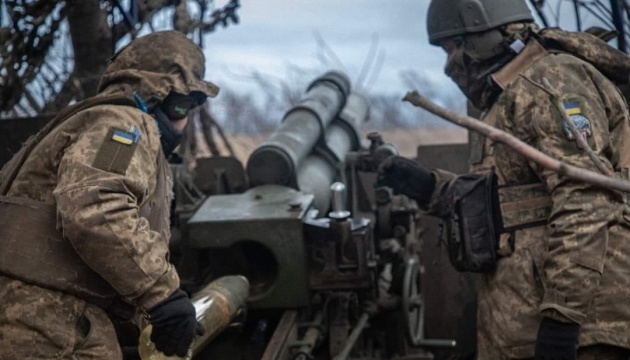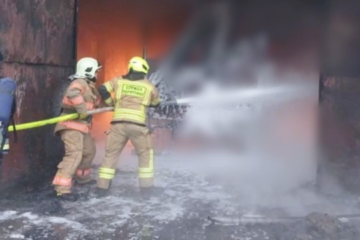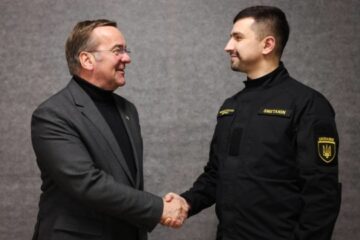The United States has imposed some of the harshest sanctions yet on Russia’s oil industry, targeting around 180 ships, dozens of traders, major oil companies and some senior Russian oil executives. The Armed Forces of Ukraine (AFU) have captured two of the North Korean soldiers who were fighting alongside Russian forces in Russia’s Kursk border region. US president-elect Donald Trump’s Ukraine peace envoy Keith Kellogg said he hopes to have a “solvable solution” between the two sides within 100 days of Trump taking office. Donald Trump has said that a meeting with Putin is being arranged.
FLASH NEWS OF THE WEEK
Donald Trump has said that a meeting is being arranged between himself and Russian President Vladimir Putin. The US president-elect gave no timeline for when the meeting might take place. “He wants to meet and we are setting it up,” he said in remarks at his Mar-a-Lago resort in Florida. Trump’s Ukraine peace envoy Keith Kellogg has said an end to the war in Ukraine could happen within 100 days of him taking office.
January 10: The U.S. Treasury on Friday announced sweeping new sanctions against the Russian energy sector, including oil majors Gazprom Neft and Surgutneftegaz, in a bid to hinder Moscow in its war with Ukraine. The sanctions also target over 180 vessels and dozens of oil traders, oilfield service providers, insurers Ingosstrakh and Alfastrakhovanie, as well as energy officials. The latest sanctions have targeted tankers accounting for about 42% of Russia’s seaborne oil exports, primarily to China. Ingosstrakh and Alfastrakhovane provide insurance for most of the ships supplying Russian oil to India.
January 10: For the first time, the UK has directly sanctioned GazpromNeft and PJSC Surgutneftegas, two Russian oil giants. These energy companies produce over 1 million barrels of oil per day between them – worth roughly $23 billion a year at current prices. The profits from these two companies are lining Putin’s war chest and facilitating his war effort. Revenues from oil are vital to Russia’s war economy, making up roughly a quarter of Russia’s entire budget in 2023.
January 5: Below are key takeaways from American blogger Lex Friedman’s three-hour podcast with President Zelensky:
– if Trump decides to withdraw the U.S. from the NATO military alliance, this would enable Putin to attack the parts of Europe that used to be under Soviet control. “Putin would like to see a weak NATO without Trump. And a weak Ukraine, which cannot survive on the battlefield, simply cannot survive”;
– Trump is the only one who can force Putin to stop the war, start negotiations and give Ukraine strong security guarantees that would prevent Russia from further aggression;
– a ceasefire without security guarantees for Kyiv would merely give Russia time to rearm for a new attack. “The West should at minimum guarantee security of unoccupied areas of Ukraine, continue weapons shipments and maintain punishing economic sanctions on Russia. “If we do not have security guarantees, Putin will come again”;
– Trump and I will come to an agreement and… offer strong security guarantees, together with Europe, and then we can talk to the Russians;
– Ukraine would be willing to negotiate a ceasefire in exchange for receiving Nato membership. Nato’s commitment could be limited to the territory still held by Kyiv, and while Ukraine would not concede the territories occupied by Russia, the goal would be to regain them “diplomatically”. The proposal for Nato membership is simply not realistic, however. Even if the alliance could fudge its own prohibition on admitting countries with ongoing conflicts or territorial disputes, giving Ukraine a membership action plan now would simply be a non-starter for a ceasefire, let alone for a long-term settlement of the conflict. Russia will not accept it;
– Ukraine could buy American weapons at the expense of $300 billion in frozen Russian assets; this is one of the security guarantees. “Take the money that we need for our domestic production, and we will buy all the weapons from the United States. We don’t need gifts from the United States”; it will be very good for your industry, for the United States. We will put money there. Russian money. Not Ukrainian. Not European. Russian money. Russian assets. They have to pay for this;
– despite the war ongoing, Ukraine is making legislative steps needed for EU integration;
– North Korea has so far lost 3,800 soldiers dead and injured in the Russo-Ukrainian war.
January 9: Defense ministers from nearly 50 countries convened at Ramstein Air Base in Germany on Thursday for the 25th meeting of the Ukraine Defense Contact Group, amid uncertainty about the forum’s future once U.S. President-elect Donald Trump takes office on January 20. Outgoing U.S. Defense Secretary Lloyd Austin said Washington would provide an additional $500 million in military assistance to Ukraine, including air-defense munitions, support for Ukrainian F-16 fighters, and air-to-ground ammunition. “Ukraine’s defensive war against Russia concerns us all,” Austin told the meeting, underscoring the possibility that this could be the last U.S. package ahead of the new administration taking over. Britain and NATO countries promised to transfer 30,000 FPV drones to Ukraine; Norway committed more than $60 million to pay for the purchase of drones for Ukraine; Germany promised deliveries of air defense capabilities, ammunition, and armored vehicles, and Canada has appropriated around $330 million in military support. The meeting endorsed eight roadmaps that define the key goals to be achieved by Ukraine’s Defense Forces through 2027. Multiple officials suggested Thursday’s session could be the last in its current form. Poland’s Deputy Prime Minister and Defense Minister Wladyslaw Kosiniak-Kamysz, speaking at the event, called the fate of the Contact Group “a key question.” He noted that several European nations, including Germany, Italy, and the U.K., want to continue the format “with a crucial U.S. role.” German Defense Minister Boris Pistorius stated that if Donald Trump opts out of future Ramstein meetings, participating nations would create “another format” to keep the coordination going. This comes after NATO Secretary-General Mark Rutte and other European officials flagged concerns over Trump’s repeated criticism of aid to Ukraine. EU foreign-policy chief Kaja Kallas told reporters she expects the United States will maintain its backing for Ukraine, but the EU is “ready to take the lead if the new U.S. administration declines.” She said it was not in America’s interest for Russia to become “the world’s strongest power.” Ukrainian President Volodymyr Zelensky, who arrived in Ramstein for the meeting, said Russian President Vladimir Putin is “doubling down” on military investment and has begun deploying soldiers from North Korea to bolster Russian forces. “They have lost 4,000 men so far,” Zelensky claimed, adding that North Korea is “gaining cheap experience” in modern warfare. Zelensky also urged partners to tighten sanctions on Russia’s energy sector, stating that the Kremlin’s 2025 military budget is 25% higher than last year. “If we want to stop the killing, we must cut off Putin’s money flow,” he said. Zelensky appealed for more air-defense systems and invited countries to invest in Ukraine’s drone industry, calling it Europe’s largest in both manufacturing and battlefield experience. “After the war, these capabilities will be your capabilities too,” he said. Commenting on North Korea’s involvement in the Russo-Ukrainian war on Russia’s side, he said Pyongyang has lost 4,000 soldiers in this war so far. NATO Secretary General Mark Rutte said allies needed to help Ukraine reach a position of strength ahead of any eventual ceasefire or peace talks.”We have to bring Ukraine into the best possible position that one day, when talks would start at the initiative of Ukraine on how to solve this conflict, that they are in the best possible position to do that,” he said. “And if it is not a good deal, it will be watched by the Chinese, the North Koreans, Iran, obviously, Russia. The whole world is watching.” With 11 days until Donald Trump’s inauguration, the meeting underscores concerns about the continuity of U.S.-led support. Austin, who originally launched the so-called Ramstein format in April 2022, said it has provided essential weapons and coordination for Ukraine. Whether future sessions proceed under Trump’s administration remains an open question. Formed on April 26, 2022, the Ukraine Defense Contact Group, also called the Ramstein Group, is an international platform uniting over 50 nations to coordinate military aid for Ukraine’s defense against Russia. Thursday’s meeting—its 25th—marked the end of one chapter of cooperation and, potentially, the start of a new phase.
January 10: President Volodymyr Zelensky spoke with US President Joseph R. Biden to discuss U.S. support for Ukraine in its courageous defense against Russia’s war aggression. President Biden updated President Zelensky on U.S. efforts to surge support to Ukraine and strengthen its position vis-à-vis Russia. Over the past several months, the United States has delivered hundreds of thousands of artillery rounds, thousands of rockets, hundreds of armored vehicles, and other critical capabilities to Ukrainian forces as they defend their freedom from Russian aggression. In addition, the United States on Friday announced a comprehensive sanctions package against the Russian energy sector, which builds upon the unprecedented sanctions regime that the United States has put in place against the Russian economy since 2022. President Zelensky expressed his appreciation for this surge in support and briefed President Biden on his strategic planning in the war. President Biden underscored the importance of continuing to support Ukraine in its fight for freedom so that the Ukrainian people can secure the just and lasting peace that they deserve.
January 10: US President Joe Biden expressed hope that Congress will continue to support Ukraine even if Donald Trump opts to cut aid after taking office, the leader said during a White House briefing on Friday. “I know that there are significant number of Democrats and Republicans on the hill who think we should continue to support Ukraine,” Biden said, “It is my hope and expectation they’ll speak up and not agree to President Trump if he decides to cut off funding for Ukraine.”
WAR AS IT IS
January 6/ Pehnyo: Ukraine has launched a fresh offensive in Russia’s Kursk region: why now and what’s the goal?
[embedded content]
January 8/ Kramatorsk Station series interview: If you want to stay alive – dig in! This is a basic security measure. Snipers too are digging in – soldier call signed “Coyote”
[embedded content]
January 9/ Dmytrashkivsky: Forgotten by the Kremlin: how civilians live in the Ukraine-controlled Kursk region
[embedded content]
January 9/ Malomuzh: Engels fuel depot is burning for the second day. What does it entail for Russia?
[embedded content]
January 8/ Russian bombs hit an industrial infrastructure target in Zaporizhzhia city
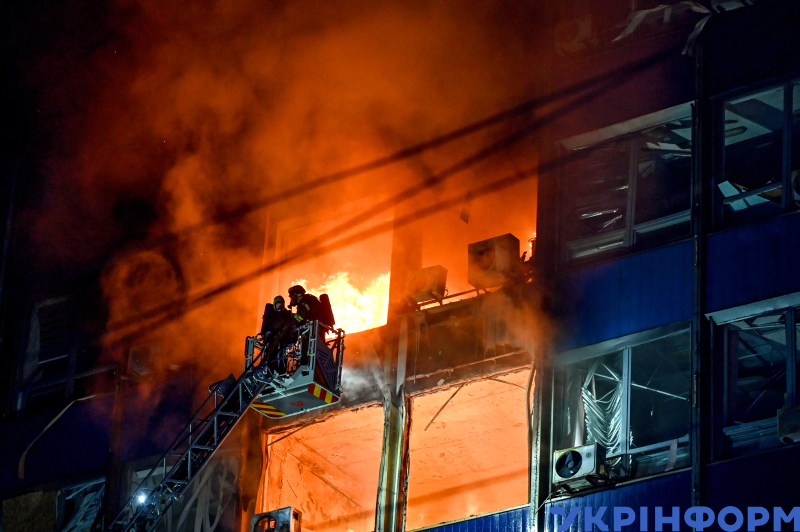
January 9/ Archery training for veterans was held in Lviv city
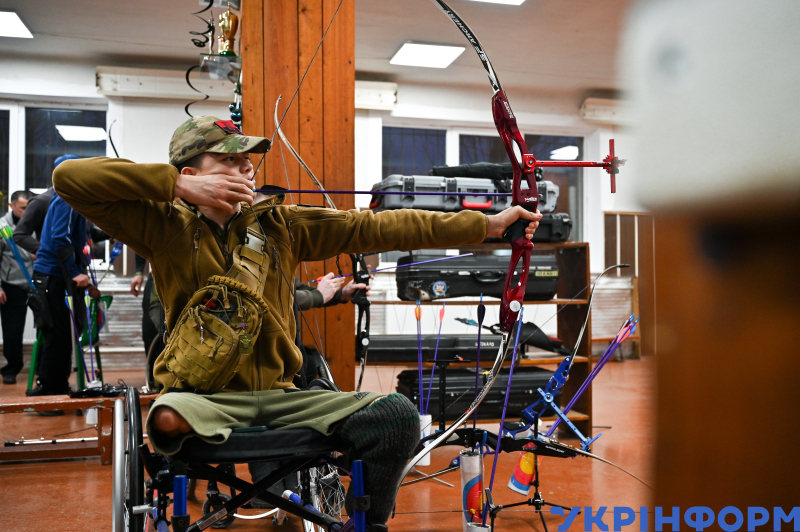
January 10/ Final farewell ceremony for Naval Infantry officer Andriy Kuzmenko took place in Kyiv
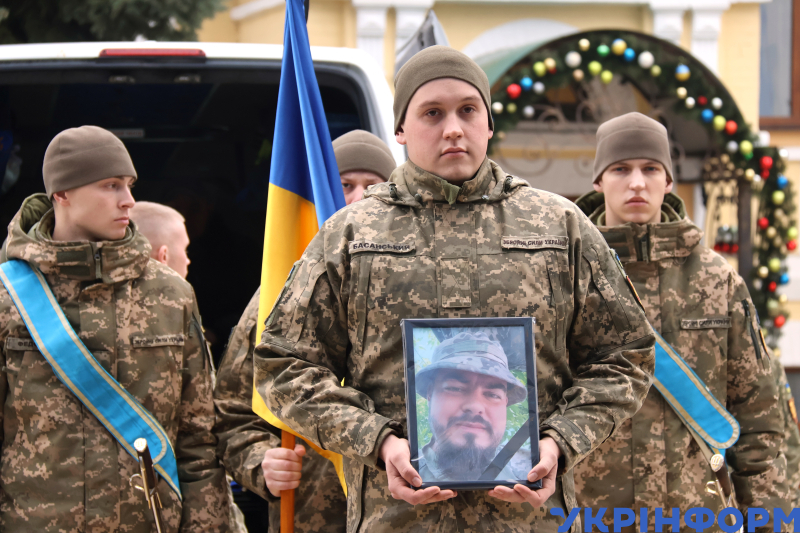
January 10/ Drone debris fell and damaged a high-rise apartment building in Kyiv
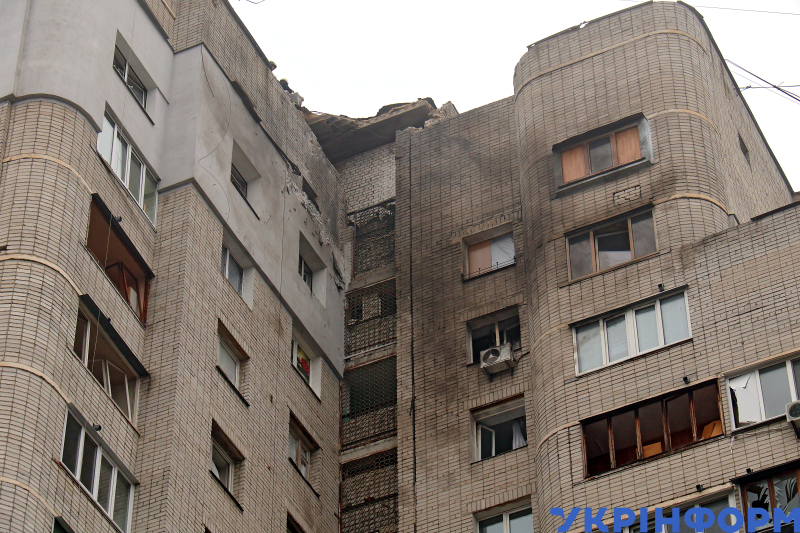
UKRAINIAN BATTLEFIELDS
January 11: President Zelensky chaired a Supreme Commander-in-Chief Staff meeting at which he urged expanding orders for the production of drones.
Attacks on the Russian Federation and Russian occupied Ukraine:
January 11: Several regions of the Russian Federation came under drone attacks; airports in Kazan, Nizhnekamsk and Ulyanovsk suspended operations due to the threat of drone strikes.
January 11: A Ukrainian drone hit the Taneko oil refinery in Tatarstan, and the local airport was reported to have suspended operations due to the attack. Taneko is the fifth largest oil refinery in Russia, with a yearly refining capacity exceeding 16 million mt. Workers at the refinery in Nizhnekamsk were evacuated amid the attack, and local footage showed plumes of smoke rising in the sky following the strike. Andrii Kovalenko, Head of Ukraine’s Center for Misinformation Countermeasures, confirmed the strike, and emphasized its strategic importance. “The refinery plays a key role in providing fuel to the Russian military. Taking out refineries and oil depots immediately affects Russia’s ability to wage an intensive war,” he said.
January 8: Ukrainian drones struck deep inside Russia in an overnight attack targeting an oil facility serving a military airfield in the city of Engels, nearly 400 miles from the border, Ukraine’s military said Wednesday. Ukrainian officials reported a huge fire at the Kombinat Kristall oil depot, which provides fuel to the Engels-2 military airfield in the Saratov region, where Russia’s strategic bomber fleet is located. The US-based Institute for the Study of War (ISW), in a report published on January 13, cited a statement from a Russian insider source, claiming that the fire at the oil depot in Engels destroyed three fuel tanks containing 120,000 cubic meters of fuel and damaged six others. At least two Russian firefighters died and another one suffered injuries while responding to the fire, the local governor has said. Images from the site showed large balls of flames lighting up the night sky and plumes of smoke continuing to billow from the site on Wednesday morning. Latest reports indicate the facility continued burning for the fifth consecutive day as of January 12. The Ukrainian General Staff noted that the attack and the subsequent ongoing fire destroyed three fuel tanks storing 120,000 cubic meters of fuel each, and damaged six others, disabling storage capacity of nearly 800,000 tons, adding that the strike has created significant logistics problems for the Russian army and substantially reduced its capability to conduct strikes against Ukrainian cities and civilian targets“.The destruction of the oil depot raises major logistic challenges for the strategic aviation of the Russian occupiers and significantly reduces their ability to strike at peaceful Ukrainian cities and civilian objects,” the AFU General Staff said.
January 8: Ukraine’s Armed Forces delivered a surgical strike targeting the command center of Russia’s 8th Guards Combined Arms Army located nearby Khartsyzk, Donetsk Oblast, according to the AFU General Staff. The building had been used by Russian occupying forces to coordinate attacks against Ukrainian forces and civilians, particularly residents of Kurakhove.
Ukraine’s Security Service, the SBU has claimed responsibility for the attack on Russia’s largest commercial port on January 4, when it targeted Ust-Luga, in the Leningrad region, using long-range drones. The SBU drones reportedly traveled over 900 kilometers, coming dangerously close to St. Petersburg, and struck tanks containing gas condensate at the port. One tank was heavily damaged, with three others suffering shrapnel impacts from the explosion.
January 12: The Ukrainian military hit the command post of Russia’s 2nd Guards Combined Arms Army, in a precision drone strike in Russian occupied Donetsk oblast on Sunday.
January 7: The AFU staged a surgical strike in the surroundings of the settlement of Belaya in the Russian Kursk region, targeting the command center of the 810th Independent Naval Infantry Brigade of the Russian Armed Forces.
January 10: Ukrainian drones attacked several Russian regions overnight on Friday, causing massive fires in Leningrad and Rostov oblasts, local authorities and Russian independent media reported. Russian air defense forces reportedly intercepted 40 Ukrainian drones throughout the night, Russia’s Defense Ministry claimed. The drone attack purpotedly triggered a heavy fire at an industrial facility in Gatchina, located 45 kilometers (28 miles) southwest of St. Petersburg. Ingria Tech, a company that sells panel coatings and paints, is located near the fire site alongside a food processing facility and a building materials plant. The Russian state news agency TASS also reported an acetone plant was on fire, which spreaded over an area of 1,900 square meters, Russia’s Ministry for Emergencies said. In another drone strike, a fire broke out at an industrial production facility near the city of Rostov, covering approx. 2,000 square meters, the Russian state-controlled news agency RIA Novosti reported.
January 10: Ukrainian forces struck a Russian army command post in Svitlodarsk in Russian-occupied Donetsk Oblast, the AFU General Staff reported Friday. In a post on Facebook, the military said the “successful hit” targeted Russia’s 3rd Army Corps. Svitlodarsk, which is located around 30 kilometers southeast of Bakhmut, has been under Russian control since May 2022. The General Staff dideclined to provide details about the weapons used in the attack or the extent of the damage inflicted, beyond saying that “all measures deemed necessary to minimize the risk to civilian lives had been undertaken”.
January 10: Ukrainain forces struck a Russian warehouse storing ammunition and reconnaissance drones using a domestically-made Neptune missile overnight on Friday, a source in the Security Service of Ukraine (SBU) said. The attack that targeted the storage facility near Chaltyr village in Russia’s Rostov Oblast was reportedly staged by the SBU in a coordinated effort with Ukraine’s Navy. Ukrainian drones purpotedly “overwhelmed” Russian air defenses, with a Neptune missile hitting the site shortly after. Videos posted on local social media show the moment of an explosion in Rostov Oblast and a high column of smoke rising over the site in the aftermath of the strike.
HOSTILITIES
January 11: Ukraine’s forces have captured two North Korean soldiers fighting alongside Russian forces in Russia’s Kursk border region, President Volodymyr Zelensky said Saturday, the first such claim by Kyiv since North Korea sent thousands of troops to shore up Moscow’s war effort on the other side of the world. Zelensky made the remarks days after Ukraine, facing a slow Russian onslaught in the east, began pressing new attacks in Kursk to retain ground captured in a lightning incursion in August — the first occupation of Russian territory since World War II. “Our soldiers have captured North Korean soldiers in Kursk. These are two soldiers who, although wounded, survived, were taken to Kyiv, and are communicating” with Ukrainian security services, Zelensky said in a post on the Telegram messaging app. Zelensky said capturing the soldiers alive was “not easy.” He asserted that Russian and North Korean forces fighting in Kursk have tried to conceal the presence of North Korean soldiers, including by killing wounded comrades on the battlefield to avoid their capture and interrogation by Kyiv. Ukraine’s security service SBU on Saturday said one of the soldiers had no documents at all, while the other had been carrying a Russian military ID card in the name of a man from Tuva, a Russian region bordering Mongolia. According to the SBU, one of the soldiers claimed he had been told he was going to Russia for training, rather than to fight against Ukraine. He said his combat unit, made up of North Koreans, only received one week of training alongside Russian troops before being sent to the frontline.
January 12: South Korea’s National Intelligence Service said Sunday it confirmed Ukraine captured two wounded North Korean soldiers this week in Russia, after Ukrainian President Volodymyr Zelensky said they were being questioned. The service said that it estimates 300 North Korean soldiers have been killed and 2,700 others wounded in battles against Ukraine.
After five months since the beginning of Ukrainian Kursk incursion in August 2024, the Russian military have lost more than 38,000 troops, 15,000 of them dead. Russia lost 1,970 soldiers killed and wounded on Ukrainian battlefields on Monday, bringing its total war casualties to 800,010 as of January 7. The Kursk incursion saw 860 Russian soldiers taken into captivity by Ukrainian forces since it began last summer, thus adding a substantial replenishment to the pool of war prisoners for future POW swaps.
COMMENT: Hamish de Bretton-Gordon, former commanding officer of the UK’s Joint Chemical, Biological, Radiological and Nuclear Regiment and NATO’s Rapid Reaction CBRN Battalion: “ Kursk may well be the beginning of the end for Putin in 2025, as it was for Hitler in 1943. The Russian front in Kursk is looking very shaky and Ukraine, rather than just hold on, could make gains. In desperation, Putin is sending one of his most trusted generals to the region in an attempt to rescue the situation. Russia seems to have plenty of expendable generals, but not the military hardware to thwart this latest Ukrainian advance. This is very encouraging. Putin may well be in ‘survival mode’ after events in Syria, the assassination of General Kirillov, and Ukraine’s decision to cut off the last gas route to Europe through its territory. Allied to this, he knows Trump is unlikely to do him any favours come Jan. 20, with the ‘mood’ music coming out of the Trump Camp, that Putin is going to have to accept a deal which probably favours Ukraine or be prepared for Trump to go full on behind Zelensky. Putin knows failed Russian dictators rarely collect their ‘pensions’ and seems to be charting a way out. His final gambit to save Kursk is putting him into ‘check’ if not ‘checkmate’”.
At Pokrovsk and Kurakhove fronts, the Russians outnumber Ukrainian forces by a factor of 5:1 in terms of personnel and hardware, deploying 150,000 troops on Pokrovsk axis and 50,000 on Kursk axis.
Russia has had to redeploy its forces from the southern and other axes of fighting towards Kursk in a bid to bolster it grouping of forces fighting off Ukrainian offensive.
January 7: The British Ministry of Defense reported in its intelligence update as of Friday that Russian forces sustained 429,660 casualties (killed and wounded) in the Russia-Ukraine war in 2024, a notable increase from the 252,940 casualties sustained in 2023. Since the start of the conflict, Russia has likely sustained over 790,000 casualties. December 2024 was likely the most costly month of the war for Russia, with a total of 48,670 casualties reported by the Ukrainian General Staff. 45,680 Russian casualties were recorded in November 2024. December marked the sixth straight month of increasing monthly total losses for Russian forces. The average daily Russian casualties reached a new monthly war high during December 2024, with an average daily loss rate of 1,570. This was the fifth consecutive month that Russian forces sustained new record-high average daily losses. On 19 December 2024, Russian forces suffered 2,200 losses in a single day, a new high. Russia is highly likely to continue experiencing high casualty rates in January 2025, with continued dismounted infantry attacks on multiple axes.
January 10: Ukrainian troops are holding their defensive lines at the Kurakhove thermal power plant amid fierce fighting on that axis, Viktor Trehubov, press officer for Khortytsia grouping of forces said in a televised appearance on Friday. “Now the Russians are trying to attack in the area of Dachne, and drive Ukrainian forces out of Kurakhove. Ukrainian forces are holding control over the thermal power plant and inflicting all the damage they can on the enemy,” Trehubov said. Kurakhove has become one of the focal points of the Russian offensive in Donetsk Oblast over the past few months, turning the town into one of the hottest stretches of the front line. Russia’s Defense Ministry claimed on Jan. 6 that its forces had allegedly seized full control over Kurakhove, a statement denied by Kyiv. An AFU spokesperson said on January 6 that Ukrainian forces continue to hold positions in the western outskirts of Kurakhove and the power plant, but the situation in the town is “challenging” for Ukrainian defenders. The town lies over 20 kilometers (over 10 miles) north of Russian-occupied Vuhledar and over 30 kilometers (almost 20 miles) south of the key front-line town of Pokrovsk. On the morning of January 11, Deep State crowdsourced monitoring website reported that Kurakhove had fell to full Russian control.
January 5: Ukrainian troops resumed offensive operation and made tactical advances in three sectors of Russia’s Kursk Oblast, the Institute for the Study of War (ISW) wrote in its Sunday update. Company-sized mechanized assaults backed by battalion-sized armored vehicles carried out three waves of attacks towards Berdin-Novosotnitsky (northeast of Sudzha), Leonidovo (southeast of Korenevo), and conducted a reinforced platoon-sized mechanized assault near Pushkarnoye (east of Sudzha). Geolocation imagery showed that Ukrainian forces advanced the fields southwest and south of the village of Berdin, entering the southern part of the settlement. Ukrainian forces also seized the settlements of Cherkasskoye Porechnoye, Martynovka, and Mikhaylovka, entered Novosotnitsky, and advanced into fields near Yamskaya Step and Novaya Sorochina. At the same time, Russian forces likely advanced in southeast of Sudzha and counterattacked southeast of Korenevo, advancing in western and southern Makhnovka and pushing Ukrainian troops out of Dmitryukov. Russian sources complained about their military’s ability to respond to Ukraine’s combined arms efforts to integrate electronic warfare (EW) and long-range strike capabilities with ground operations. Russian troops were hampered in their ability to defend against Ukrainian mechanized attacks by interference with Ukrainian EW warfare systems.
January 6: Invading Russian forces are carrying out assault operations in the urban development of Kurakhove, while simultaneously attacking towards Petropavlivka and Dachne. Measures are underway to expose and take out the enemy’s assault groups.
January 6: The adversary staged a wave of overnight attacks aimed to destroy civil transport infrastructures and a bridge crossing over the Oskil river near Kupiansk, thus complicating humanitarian logistics and civilian evacuation efforts.
January 7: Viktor Trehubov, press officer for the Khortytsia Operational and Strategic Group of Forces has dismissed reports that Russian troops had allegedly won full control over the settlement of Lozova in Kharkiv oblast. “As far as Lozova is concerned, I am at odds where the information about its occupation came from, [because] the reports coming from the filed say the otherwise,” Trehubov said in a televised appearance Tuesday, adding that no serious combat clashes have reportedly been taking place in Lozova so far. The crowdsourced monitoring website DeepState reported in an earlier update that Lozova in Kharkiv region’s Izyum district fell to Russian control.
January 7: The situation remains high-risk for Ukrainian defenders of Kurakhove. The Russians are endeavoring to reduce to ruins all the buildings in town, including even low-rise houses. Ukrainian troops are holding on to the western part, on its western outskirts, including holding the Kurakhove thermal power plant.
January 7: The 8th Regiment from the AFU’s Special Operations Forces wiped out 13 North Korean soldiers fighting alongside Russian forces in the Russian border Kursk region.
January 8: The AFU’s Special Operations Forces, supported by other elements of the Defense Forces, thwarted attempted assaults on defensive Ukrainian positions in the Kursk region, destroying five hostile armored vehicles.
January 8: Ukraine’s Defense Forces successfully fended off a mechanized Russian assault targeting Malynivka village in Donetsk oblast.
The Russian troops are pressing on towards Chasiv Yar, Stupochky and Toretsk, making a massive use of one-way attack drones and destroying some of Ukrainian fortifications.
January 8: Overnight on Wednesday, the invading Russian forces achieved tactical gains in the areas of Toretsk, Kurakhove, Novovasylivka, Slovianka, Neskuchne, and Yantarne in the Donetsk region, and advanced closer towards Dvorichna in the Kharkiv region, and towards Novoivanovka and Novaya Sorochyna in Russia’s Kursk region, according to DeepState monitoring website.
January 9: Soldiers from the 47th Magura Independent Mechanized Brigade, assisted by allied elements of the Defense Forces, foiled a massive enemy assault in the Kursk region, taking out 45 Russian troops killed.
January 9: Russian forces assaulted Ukrainian fortifications in Bilohorivka, Siversk axis, destroying some of them. Ukrainian defenders are taking measures to avert further tactical losses.
January 9: Border guard soldiers from Phoenix UAV unit within Pomsta (‘Revenge’) Brigade, using one-way attack drones, attacked and burned out armored vehicles and warehouses used by Russian forces deployed in the areas of Kreminna and Serebrianka forest.
Russian forces fighting on Zaporizhzhia axis are assaulting Ukrainian fortifications in small groups of infantry travelling on ATVs and buggies.
January 10: On Pokrovsk axis, Ukrainian forces thwarted 42 Russian attacks; the adversary forces fighting on Kurakhove axis are seeking to destroy buildings whenever possible to facilitate their advance.
January 11: The occupying Russian army destroyed some of the defensive Ukrainian positions on Kupyansk, Kramatorsk and Toretsk axes.
January 12: Intense urban fighting is ongoing in Chasiv Yar, Donetsk oblast, as Russian forces are struggling to seize control over the refractory factory and the Kanal residential area, according to Viktor Trehubov, press officer for the Khortytsia Operational-Strategic Group of Forces. “Fierce urban battles are currently ongoing in Chasiv Yar. The enemy is once again attempting to advance on the refractory factory (Chasiv Yar Refractory Plant, – ed.),” he said, adding further that “Ukrainian forces are persistently resisting and have been successful in their efforts so far.”
January 12: Russian troops have been spotted dressed in civilian clothing to camouflage their movements in Toretsk, Donetsk Oblast, Ukraine’s 28th Mechanized Brigade reported on Sunday. Aerial reconnaissance footage posted by the brigade on Facebook shows a couple of alleged Russian soldiers disguised as civilians. The brigade branded this as a “new breach of the rules of war” by Russian troops, which can be classified as a war crime under international law. Russian infantrymen “attempt to divert attention and disguise themselves” in this way, the Brigade said, adding, “However, they are exposed by their identical clothing, behavior, and sometimes even their weapons”. “Nevertheless, this still complicates the work of our soldiers, as the Ukrainian Armed Forces do not ‘shoot at everything that moves,’ unlike (Russian) occupiers.”
January 12: Russian forces are attempting to bypass Pokrovsk and Myrnohrad in Donetsk Oblast from the south, engaging in combat in the suburbs, Viktor Trehubov, press officer for the Khortytsia Operational-Strategic Grouping of Forces, said in a televised address broadcast on Sunday. Russians are trying to bypass these cities through smaller settlements, mostly from the south, attempting to cut off logistics chains rather than assault well entrenched defenses head-on,” he said, adding, “They need to spare resources now, operating differently from their usual approach of rushing forward regardless of personnel losses to capture territory quickly.” Trehubov noted that this tactical change indicates Russians no longer maintain their previous advantage in personnel and equipment.
January 12: Ukrainian forces advanced in northern Pogrebki (northwest of Sudzha, Russia’s Kursk oblast) amid ongoing fighting in the area.
THE WEEK IN NUMBERS AND PICTURES
Russian drone and missile attacks on the Ukrainian regions of Donetsk, Kherson, Zaporizhia, Dnipropetrovsk and Kharkiv left 10 civilians dead and 70 others injured over the week reviewed.
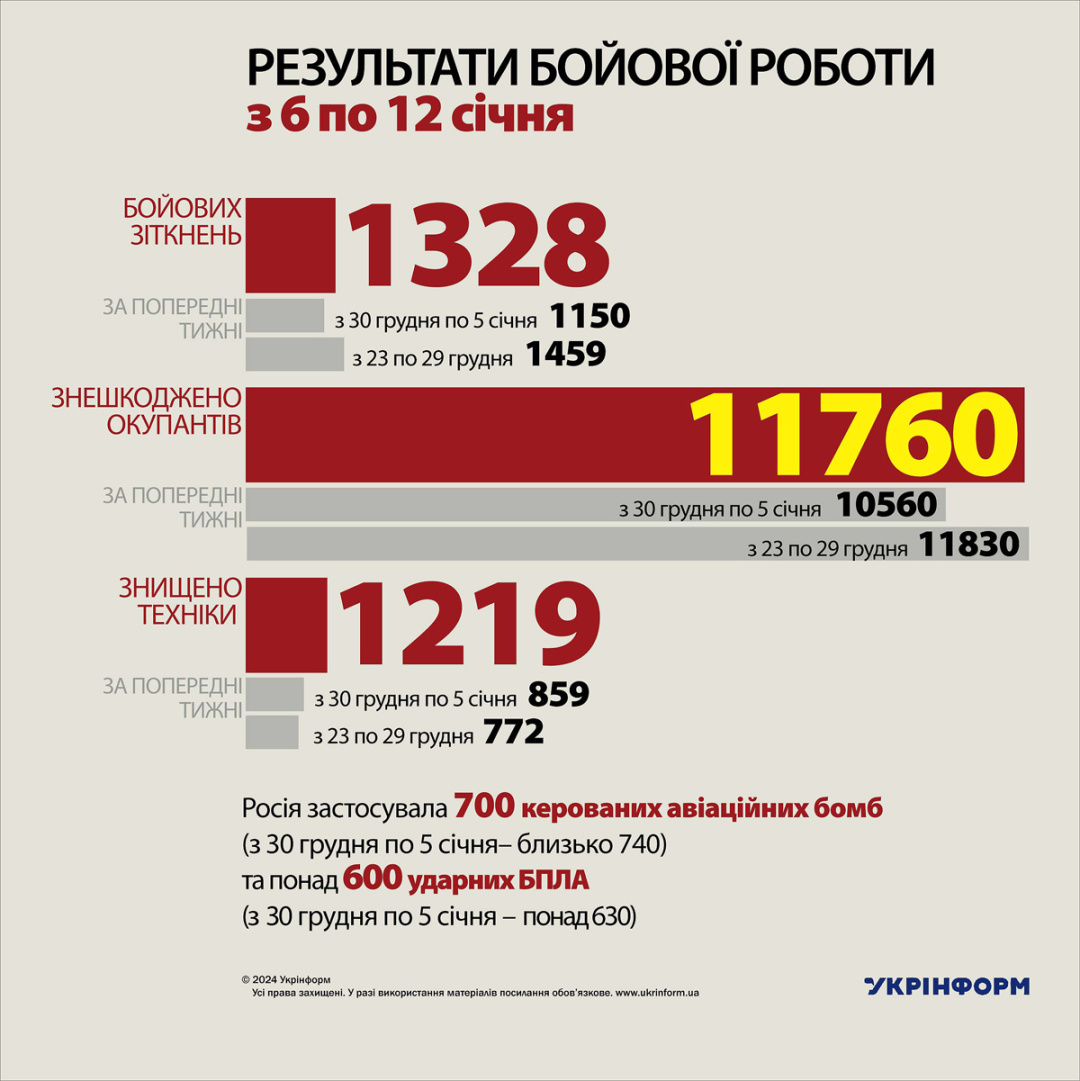
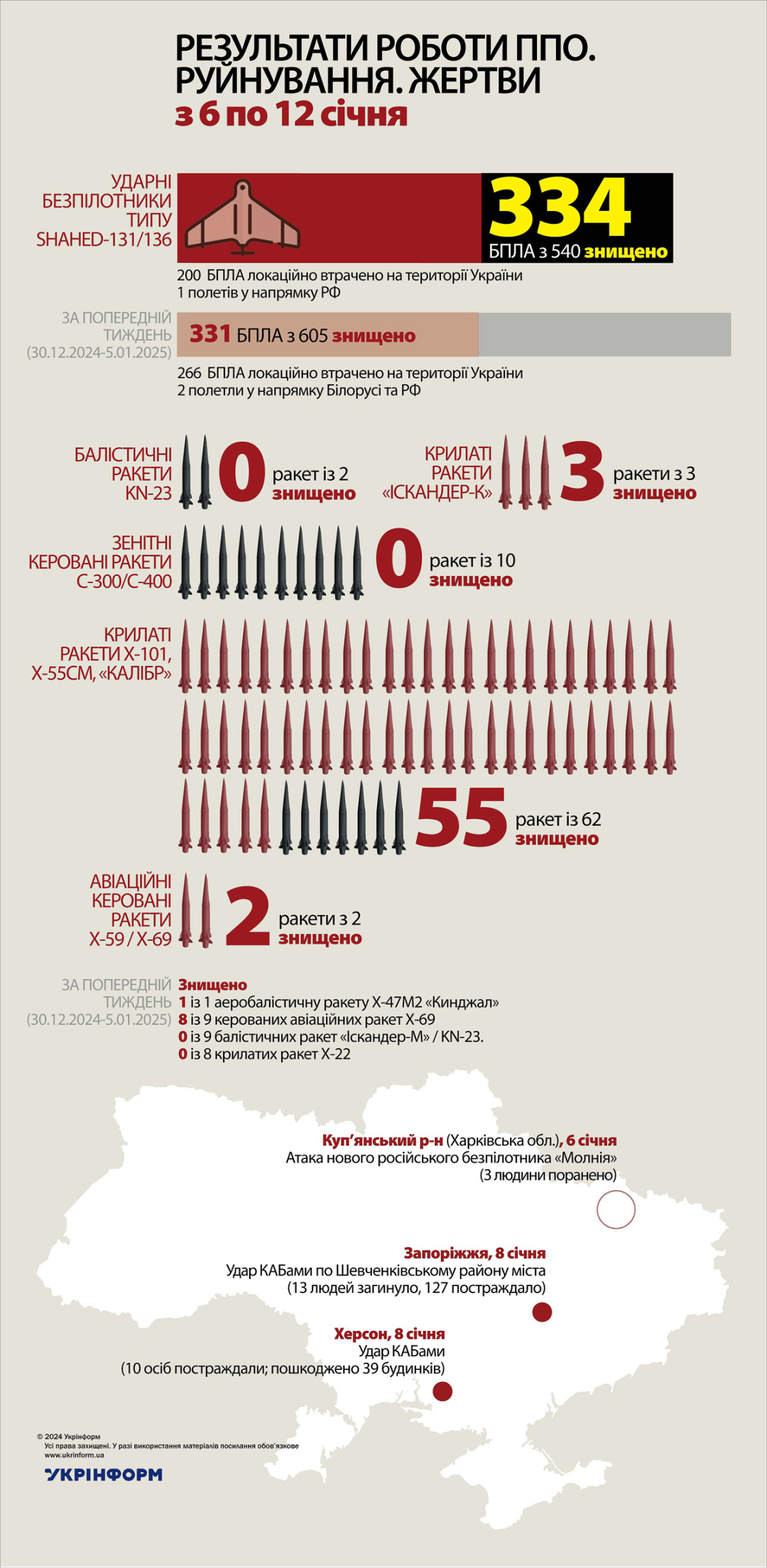
WAR AFTERMATH
Human casualties & War crimes
January 11: Russian troops dropped two precision glide bombs on a nursing home in the Ukrainian-occupied Russian town of Sudzha, Kursk Oblast, Ukrainian military spokesperson Oleksii Dmytrashkivsky said in a televised appearance Sunday. According to Dmytrashkivsky, the airstrike, which took place on Saturday night, left one woman with severe arm injuries, who died the following day. The attack also dealt heavy damage to the nursing home’s building, with all windows smashed and doors blown out. Around 2,000 Russian civilians remain in areas under Ukrainian control, and over 70 people are currently staying in the nursing home that came under attack, Dmytrashkivsky said. “The question now is where to relocate these people. Most are elderly, and many suffer from disabilities, Parkinson’s disease, post-stroke conditions, and one individual has a mental illness. The current condition of these people is quite severe,” he said. The news comes days after Ukraine renewed its offensive operations in Kursk Oblast, which is seen as a crucial bargaining chip for potential peace talks. More than three dozen local civilians have been killed and over a hundred others injured in Russian bombing and shelling attacks on Sudzha over the time of Ukrainian Kursk incursion. Dmytrashkivsky also dismissed as “blatant lie” the claims by Russia’s Ombudsman Tatyana Moskalkova that 517 civilians have allegedly been missing in the Kursk region in the aftermath of the Ukrainian offensive.
January 6: Russian forces seem to have gunned down three surrendering Ukrainian soldiers near Neskuchne in the Donetsk region. This comes as another apparent case of Russia summarily executing Ukrainian prisoners of war (POW) or surrendering soldiers, which could amount to war crimes. Dmytro Lubinets, the Ukrainian Ombudsman has communicated the case to the International Committee of the Red Cross and the UN.
Almost 30,000 Ukrainians, including military personnel and civilians, have been declared missing since early 2024, according to Artur Dobroserdov, Ukraine’s Commissioner for Persons Missing under Specific Circumstances.
The UN Human Rights Monitoring Mission in Ukraine (HRMMU) documented a continued high level of civilian casualties due to intense hostilities near the frontline. At least 574 civilians were killed and 3,082 others suffered injuries in the aftermath of Russia’s war of aggression against Ukraine between September and November 2024, according to a HRMMU’s report released on Dec. 31. In September, civilian casualties rose to their highest monthly level since July 2022. Intensified military operations by Russian forces in Donetsk Oblast and the use of precision glide bombs and short-range drones contributed to the high number of civilian casualties. Most casualties (93%) were recorded in Kyiv-controlled areas, particularly in Donetsk, Kharkiv and Kherson oblasts, where the intensity of hostilities “remains the highest”.
Russian forces have launched more than 51,000 precision glide bombs on Ukraine sine the beginning of the full-scale military invasion, including around 40,000 bombs dropped during 2024.
January 6: Volodymyr Rakov, choreographer and winner of the sixth season of the “Everybody Dance!” TV dancing show died defending Ukraine against Russian invasion. Eternal memory to the Hero…
January 7: A Scottish man has been killed while serving on the frontline alongside the Ukrainian army, his family has said. Jordan Maclachlan, 26, from Ardnamurchan in the Scottish Highlands, died on Friday while serving as a medic with the Ukrainian army. Maclachlan is not the first Briton to die while fighting in Ukraine. In November, Callum Tindal-Draper, 22, was killed while fighting in Ukraine for the country’s foreign volunteer platoon. In November 2023, Christopher Perryman, a British ex-army sniper, was killed fighting in Ukraine after he joined the unit of western volunteers.
Culture
The aftermath of Russia’s full-scale military invasion of Ukraine includes 382 establishments of culture reduced to ruins and 1,774 others severely damaged as of December 25, 2024.
UKRAINIAN HOME FRONT
President Volodymyr Zelensky:
– made amendments to the Statute of the AFU General Staff;
– made amendments to the country’s National Security Strategy insofar as it pertains to national border security;
– issued a decree establishing the Day of the State Service for Special Transport, to be celebrated annually on February 5;
– enacted a law to bring the national legislation on the rules of judicial procedure in line with EU legislations;
– enacted legislation establishing the Ground-Based Aviation Day to be celebrated annually on July 3.
January 7: Ukrainian Foreign Minister Andrii Sybiha received his visiting counterpart Ms Thorgerdur Katrin Gunnarsdottir of Iceland, who visited Kyiv for the first time in her role as Foreign Minister, making a milestone in Ukraine-Iceland relations. The discussion focused on Iceland’s support for Ukraine’s Peace Formula, further isolating Russia politically and economically and increasing the cost of its war of aggression. Iceland has contributed €2M to Ukrainian weapons production via the “Danish model” and provides assistance with mine qaction, logistics, military training, and prosthetics for wounded soldiers. Energy support and humanitarian aid, including the “Grain from Ukraine” initiative, remain priorities. This visit builds on last year’s security agreement and Zelensky’s visit to Reykjavik, deepening the partnership between the two countries. As part of her visit, Ms Gunnarsdottir made a trip to a Ukrainian thermal plant to see firsthand the destruction caused by Russian attacks, and she laid flowers at the Kyiv Wall of Remembrance for those who died defending Ukraine.
January 8: A US delegation led by Winfield Swanton, who is responsible for Ukraine affairs at the US National Security Council, visited Kyiv to review the outcomes of the US aid provided to Ukraine during 2024 and hash out plans for cooperation between the countries’ defense establishments for 2025. The sides additionally discussed the status of previously announced investments in Ukrainian drone production industries, as well as the advancement of other defense industrial collaborations.
January 8: The 2025 OSCE Chairperson-in-Office, Minister for Foreign Affairs of Finland, Elina Valtonen visited Kyiv for meetings with President Volodymyr Zelensky and Foreign Minister Andrii Sybiha.
***
Ukraine has no intention to contract for Russian gas transit to Europe. Instead, the country will focus on boosting domestic gas production to exceed 20 billion cubic meters in the coming years – Prime Minister Denys Shmyhal.
The Ministry of Justice has restored the Unified State Register back into operation after a massive Russian cyberattack of December 19.
As part of the Grain from Ukraine initiative, Ukraine has committed to deliver more than 1.9 million mt of sunflower oil and flour to African countries this winter, according to Minister of Agrarian Policy and Food Vitalii Koval. “As part of the Grain from Ukraine initiative, Ukraine has already sent sunflower oil to Mozambique. Almost 416 tonnes is scheduled to arrive in early February. Additionally, 73.4 tonnes of oil and 970.5 tonnes of flour will arrive in Djibouti by the end of January. We will also soon ship 453 tonnes of sunflower oil to Tanzania,” the minister said in a Facebook post Sunday.
The Ministry of Defense has codified and approved for operational use the D-21 ground robotic system, a product designed and developed by the leading Ukrainian defense cluster Brave1. The D-21 robot boasts an automatic turret and exceptional adaptability, ready to address diverse battlefield needs. It is equipped with capabilities ranging from reconnaissance/surveillance to offensive/defensive operations. Beyond combat, the D-21-11 robot can double as a logistics carrier. Its modular design allows for the seamless integration of detachable cargo units, enabling the safe and efficient delivery of ammunition and provisions to troops in the firld, even in the most hostile environments.
Around three dozen mental health centers had been operating in Ukraine as of early 2025.
January 9: Thirteen laboratory-confirmed cases of human metapneumovirus (HMPV) infection have been recorded in Ukraine as of January 6, but there are no signs indicating the virus would spread readily in the population, the Kyiv City Center for Disease Control and Prevention has reported.
January 6: Oleh Snitovsky, Honored Journalist of Ukraine and former Ukrinform reporter, died at the age of 70.
January 7: Ukraine has withdrown from the 1996 CIS agreement on the Great Patriotic War veterans visiting soldiers’ graves and war memorials.
January 7: The Cabinet of Ministers dismissed Ruslana Velychko-Tryfonyuk as Vice Minister for EU Integration at the Ministry for Veterans’ Affairs. The dismissal followed a controversy involving disrespectful behavior towards veteran Yevhen Shybalov, who served as head of the Department of European Integration and International Cooperation. Shybalov announced in his Facebook post Monady that he had submitted resignation due to a lack of respect for his honor and dignity on the part of the ministerial leaders.
January 7: Defense Minister Rustem Umerov has appointed former Vice Prime Minister – Minister for Community and Territorial Development and Infrastructure Oleksandr Kubrakov as his advisor pro bono.
January 7: A survey released on Tuesday by the Kyiv International Institute of Sociology (KIIS) showed that Ukrainians’ trust in President Zelensky had fallen to 52 percent as of December last year, compared to 90 percent in March 2022, just weeks after Russia invaded. Just seven percent of respondents in March 2022 said they actively did not trust the 46-year-old leader. That figure has since grown to 39 percent, the poll showed. “The weakening of trust in Zelensky indeed reduces his future potential and weight as a public figure,” said the institute’s executive director, Anton Grushetsky, in an analytical note.
The Verkhovna Rada of Ukraine:
– approved a second reading of the bill on the advancement of volunteering among vocational training seekers, including the right to recognition of acquired competencies;
– adopted a legislation to return to the mandatory monitoring, reporting and verification of greenhouse gas emissions;
– endorsed a bill to empower foreign nationals who are spouses of Ukrainian citizens and who were (are) involved in the defense of Ukraine’s territorial integrity and inviolability of the national border to obtain Ukrainian citizenship.
January 7: Ukraine has offered to replace Hungary in NATO and the EU in a statement released by the Ministry of Foreign Affairs on Tuesday as tensions between the two countries increase due to Budapest’s support of Russia in the war. In the statement published on Wednesday, Ukraine’s Ministry of Foreign Affairs wrote: “The latest manipulative statements from the leadership of Hungary regarding Ukraine’s decision not to extend the transit agreement with the aggressor state, Russia, from 2025 onward, allegedly having a negative impact on consumer prices, are part of a politically motivated information campaign intended for domestic consumption.” The ministry added that the “European Commission clearly indicated that Ukraine’s previously announced decision did not adversely affect the energy security of EU countries or consumer prices in the European market.” The ministry said that only two out of 27 EU countries have struggled to “secure their economies and citizens with alternative energy supplies from the United States and the Middle East.” The Ministry of Foreign Affairs added that the two countries, which are not named, in trying to retain energy relations with Russia have “effectively obstruct[ed] access to the European energy market for resources from the United States and other partners.” The ministry concluded: “If the Hungarian side prioritizes strengthening Russia over the EU and the United States, it should acknowledge this explicitely. Ukraine would be ready to fill any vacant space in the EU and NATO if Hungary chooses to vacate it in favor of membership in the CIS or CSTO [Commonwealth of Independent States and Collective Security Treaty Organization.]”
January 11: Ukrainian and Estonian prosecutors inspected sites of Russian war crimes in the Odesa, Mykolaiv and Kherson regions, and agreed to advance cooperation to ensure justice is restored and the aggressor state is held accountable for war crimes it committed in Ukraine.
January 8: The Ministry of Defense introduced new standards for training in pre-hospital medical care, focusing on the effective provision of emergency care immedietaly on the battlefield and in otherwise extreme situations.
Since the start of the campaign to declare the possession of previously undeclared firearms, 2,100 Ukrainians have declared more than 2,500 firearms possessed.
WAR ECONOMY
Ukraine’s foreign currency reserves surged by 9.7 percent in December to exceed $43.78 billion as of January 1, breaking a record high, Ukraine’s National Bank (NBU) reported on its official website.
During 2024, UAH 2.177 trillion worth of taxes, fees and mandatory payments was transferred to the base national budget, with every ninth hryvnia coming from personal income tax and military tax on personal income.
The amount total of cash expenditures from the National Budget reached UAH 704.7 billion in December 2024, breaking a record high compared to UAH 426.3 billion reported for the previous month. This includes UAH 491.9 billion worth of expenditures from the base budget, compared to UAH 340.2 billion spent in November.
Annual inflation rate accelerated to 12 percent in December 2024, while consumer prices grew by 1.4 percent.
In December 2024, Ukraine’s merchandize exports amounted to USD $41.6 billion and merchandise imports reached USD 70.7 billion. The full-year trade turnover for 2024 increased by 13 percent year-on-year, from USD $99.4 billion in 2023.
In 2024, nearly 210,000 individual entrepreneurs in Ukraine shut up their businesses. This is 32 percent up from the previous year and the highest reported in five years.
266 auctions for the sublease of state agricultural land held in October-December 2024 under the Land Bank program raised a combined revenue of UAH 757 million.
The Winter eSupport program surpassed all the other Diia programs in terms of the number of applications submitted; 9.4 million Ukrainians submitted applications through Diia, with another 2 million receiving payments through Ukrposhta [national mail operator].
ALLIED AND PARTNERS’S AID
The visit by the President of Ukraine to Italy on January 9-10:
January 9: President Zelensky met Italian Prime Minister Giorgia Meloni in Rome. The discussion addressed important matters such as the provision of missiles for the SAMP/T aid defense system, political partnership, and coordinating the Conference on the Reconstruction of Ukraine, scheduled for July 10-11, 2025, in Rome.
January 10: President Volodymyr Zelensky met with President Sergio Mattarella in Rome. The talks focused on matters of sustainable and lasting peace for Ukraine, backing Ukraine on its path to NATO and EU integration, tightening Russia sanctions, and rescuing Ukrainian children from Russian abduction.
***
The final $500M military aid package from the Biden administration to Ukraine, drawn from the Pentagon’s existing stockpile under the Presidential Drawdown Authority (PDA) program, is expected to be the last from the outgoing administration before President-elect Donald Trump’s inauguration on Jan. 20. Despite previous commitments to exhaust the remaining PDA funds, approximately $3.8 billion will remain unused, leaving the funds at the disposal of the incoming administration.
At the conclusion of the 25th meeting of the Ukraine Defense Contact Group (UDCG), the last such meeting for Secretary of Defense Lloyd J. Austin III, the outgoing secretary challenged group members to maintain the level of support to Ukraine they have built over the past three years. The UDCG member countries altogether have contributed more than $126 billion in security assistance to Ukraine. That includes tanks, air defense systems, combat vehicles, munitions, F-16 aircraft and training for pilots, Austin said. In providing that equipment, Austin said, the United States and other UDCG member nations have also increased support to their own defense industrial bases. “The Ukraine crisis exposed some shortcomings in our defense industrial base,” he said. “We’ve still got a lot more work to do. But we have galvanized our own defense industry, investing nearly $70 billion at home to produce capabilities for Ukraine and replenish our own stocks.”
Ukraine has taken a decisive step by ending the transit of Russian gas, aiming to deprive the Kremlin of around $6.5bn in revenue from energy exports to Europe and possibly affecting Russia’s ability to fund its invasion of Ukraine.
Germany’s Rheinmetall delivered Ukraine the first KF41 Lynx combat vehicle built at Rheinmetall’s facility in Unterluß.
January 10: The European Commission has disbursed the first €3 billion tranche of its exceptional Macro-Financial Assistance (MFA) loan for Ukraine, which will be repaid with proceeds from immobilised Russian State assets in the EU. This loan, amounting up to €18.1 billion, represents the EU’s contribution to the G7-led Extraordinary Revenue Acceleration (ERA) loans initiative, which collectively aims to provide approximately €45 billion in financial support to Ukraine.
January 6: U.S. President-elect Donald Trump’s incoming Ukraine envoy has postponed a fact-finding trip to Kyiv and other European capitals until after Trump’s inauguration on January 20.
January 6: The Ukrainian Ministry of Defense has commissioned Rheinmetall to deliver additional 35mm ammunition for the Gepard anti-aircraft gun. The new order comprises 180,000 rounds of HEI-T ammunition (High Explosive Incendiary with Tracer) and was announced in December of 2024. The order value is in the high double-digit million euro range and is being funded by Germany. Already in February of 2023, Rheinmetall received an order to supply 300,000 rounds of Gepard ammunition to Ukraine.
January 6: A draft resolution to recognize Russia’s war against Ukraine as genocidal was among the first bills submitted to the new U.S. Congress on Monday. The resolution cites the Russian military’s intentional targeting of civilians, civilian infrastructure, systematic sexual violence against Ukrainian women, men, and children, as well as the forced deportation of Ukrainian children to Russia.
Incoming U.S. President Donald Trump wants NATO members to spend a whopping 5 percent of GDP on defense — more than double the alliance’s current spending target. Many European countries are facing budget crunches and are struggling to reach even the 2-percent goal. Italy will spend 1.57 percent of GDP on defense this year and aims to reach 2 percent in 2028. The U.S. last year spent 3.4 percent of its GDP on defense; Poland comes closest, spending 4.12 percent in 2024, and aims to boost that to 4.7 percent this year. Spending tends to be higher the closer a country is to Russia, and the three Baltic countries are dramatically increasing their military budgets.
January 10: German Chancellor Olaf Scholz blocked a proposal for an additional €3 billion aid package for weapons to Ukraine, according to a local media report. The plan, revealed by Spiegel, was introduced by Foreign Minister Annalena Baerbock and Defense Minister Boris Pistorius. It sought to provide Ukraine with critical weapons systems, including three additional Iris-T air defense batteries, 10 howitzers and more artillery ammunition. According to the report, the aid package was developed immediately following the collapse of the coalition government in November, with Baerbock and Pistorius aiming to secure parliamentary approval for the funding before February’s snap federal elections. Despite their efforts, Scholz remained opposed. The incumbent chancellor reportedly argued that existing military aid allocations — €4 billion for 2025, alongside funds from a $50 billion G7 loan financed by frozen Russian assets — are sufficient. He expressed concern over committing the incoming government to major financial obligations after the election.
January 10: Tokyo announced Friday that Japan is freezing the assets of 33 organizations and 12 individuals, including a North Korean national, under the country’s foreign exchange and foreign trade law. An additional 53 organizations from Russia, China and other countries became subject to export bans and other measures. Japan was taking the actions in response to North Korea’s support for the Russian war effort and Russia’s use of third nations to evade previous sanctions. Japan has also banned exports of 335 items to Russia starting on January 23. The items include small motorcycles and components for special-purpose vehicles such as cranes.
January 9: U.S. President-elect Donald Trump said on Monday he is going to meet Russian President Vladimir Putin “very quickly” after he takes office next week. He did not provide a timeline for the meeting, which would be the first between the leaders of the two countries since Russia’s war with Ukraine started in February 2022.
January 12: Mike Walz, the incoming national security adviser, said on Sunday he expected a call between Trump and Putin in “the coming days and weeks”
COMMENT: Heorhiy Tykhyi, spokesman for the Ministry of Foreign Affairs: “Donald Trump had announced plans for such a meeting (with Putin – ed.) previously, so we do not see anything new in this. The Ukrainian position is very simple: we all want to end the war fairly and we see that President-elect Trump is also determined to end the war. The main thing now is that we are waiting for a meeting between Trump and Zelensky, because for us the main thing is to work together with America.”
January 10: Ukraine and Poland have agreed to allow the exhumation in Ukraine of victims of the World War Two Volhynia massacres, in which around 100,000 ethnic Polish civilians were killed. The issue has long been a source of tension between the two neighbours and allies.
January 10: Almost 1,300 Ukrainians living in Poland, Denmark, Czechia, Germany, Lithuania, and other European countries have applied to join the Poland-based Ukrainian Legion, the Defense Ministry said on Friday. The ministry said that the second group of volunteers had already signed contracts in Lublin. For the first time, the new recruits included women who applied for medical and communications roles.
January 8: Hungarian Foreign Minister Peter Szijjarto condemned a Ukrainian parliamentary bill proposing the suspension of Russian oil and gas transit through Ukraine amid martial law, calling the measure “unacceptable” in a Facebook post on Wednesday. “The reality is that in the EU, member states collectively and unanimously decide on the admission of new members. In other words, each member state has to vote in favor,” Szijjarto said, probably referring to Hungary’s influence over Ukraine’s EU aspirations. The bill, submitted on Jan. 7 by ex-President Petro Poroshenko and members of the opposition European Solidarity party, would ban Russian energy transit through Ukrainian territory. Ukraine had already decided not to renew its gas transit deal with Russia beyond Dec. 31, 2024, but continues to allow Russian oil to flow via the Druzhba pipeline under a contract valid until the end of 2029.
January 12: Slovak Prime Minister Robert Fico sharply criticised Ukrainian President Volodymyr Zelensky, calling him a “beggar” and accusing him of “begging and blackmailing” European nations for financial aid. Fico made his comments at a meeting of Slovakia’s Foreign Affairs Committee. He expressed frustration with Zelensky’s efforts to gather support, claiming Slovakia and the EU have already contributed significantly to Ukraine’s war effort. Fico refused Ukraine’s offers of assistance following the discontinuation of Russian gas flows via Ukrainian territory, President Zelensky said in a post on X Sunday. Zelensky’s comments come shortly after Fico lambasted Ukraine as an unreliable partner. “We offered our assistance to the people of Slovakia during their adaptation to the absence of Russian gas transit, but Fico arrogantly refused,” Zelensky said, adding, “Many in Europe warned him that doing nothing and waiting was not an option. Now, he’s resorting to PR, lies, and loud accusations to shift the blame away from himself onto someone else.”
January 7: Finnish and Swedish authorities have recovered the missing anchor of the Russia-linked dark fleet tanker Eagle S, which was seized by Finland on suspicion of severing four fiber-optic cables and a power cable in the Gulf of Finland on December 25.
WAR&LIFE
January 6/ Ukrainians abroad: what are the chances of our own being returned back home
QUOTE: “Even if the conditions for refugees in Europe worsen, there is a willingness to stay there and the means to do so. And everyone will be useful to Ukraine – at least as a consumer.”
January 7/ Ukrainian Kursk incursion: what the AFU need to achieve a success
QUOTE: “From the war perspective, there is a continuing (more or less large-scale) elimination of the enemy. Plus, successful tactical maneuvers such as strikes on command centers (like in Lgov), which paralyze the control, command, and communication system for a certain while, thus weakening the enemy.”
January 8/ Why the EU should abandon condensed gas and pipeline oil from Russia
QUOTE: “The termination of the Russian natural gas flow through the Ukrainian gas transportation system will leave the aggressor state without $4.5 – $6 billion in annual revenue… But the Russian Federation continues making money from liquefied gas and pipeline oil sales to the EU, thus feeding its war effort. It would therefore be fully logical for the international sanctions policy to expand restrictions to include the specified energy market segments.”
January 9/ Transnistrian crisis: who did the Kremlin really intend to freeze
QUOTE: “The crisis in Transnistria is a chance for Moscow to destabilize the situation, to oust Sandu from power, and ultimately nullify her as president as much as possible”. The [Moldovan] president avoids having allies, builds up an independent policy, and this will create problems for her in the future parliament.”
Compiled by Maryna Dmytriv, Kyiv
Source: Ukraine Latest: Weekly Digest for January 6-12, 2025

